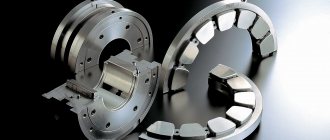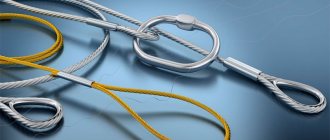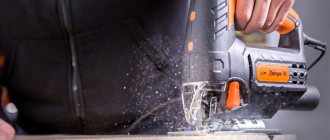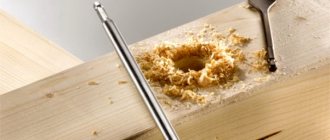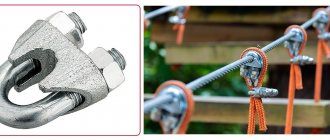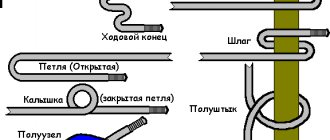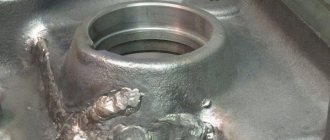An electric or regular jigsaw is useful for a creative craftsman, since the equipment allows you to cut shaped or straight cuts from a wide variety of materials, from soft wood to glass or even steel. The versatility of the tool lies in the files, each of which serves a specific task. Therefore, it is very important to understand their classification and know how the file is secured in the jigsaw clamps.
Jigsaw
Classification of jigsaw files by type of material being processed
Initially, when jigsaws were not yet electric, this equipment was used only for wood processing. But modern devices allow you to cut metal, plastic and any type of wood surface. Therefore, before purchasing a jigsaw (Bosch, Makita or similar models), you need to decide on the material to be processed. After all, depending on the purpose, you will have to look for a specific cutting blade.
For wood and wood materials
Files for wood processing are divided into several groups:
- Quick cut Sometimes the quality of processing of wood material is not as important as the speed of the process itself. For such work, a long blade (from 60 mm) with large teeth (up to 6 mm) is suitable. If the master is going to make a longitudinal cut, then it is advisable to buy files with oblique teeth. And for a cross cut, a straight “tooth” is used.
- Clean cut (average tooth size not exceeding 3 mm, as well as a slight gap). Such files are usually used in furniture assembly plants.
- Figured cut. It is difficult to make a curved cut with a small radius, so special shaped files are used that have a very narrow blade, not exceeding 4 mm. The canvas is also characterized by small teeth (up to 2 mm) and short length (40 mm).
Important! If you choose the wrong file, there is a risk of overheating the motor of the jigsaw (models Dexter, Whirlwind and others).
For metal
Cutting metal is not the most obvious solution when working with a jigsaw, but this is possible thanks to a special blade. But, it should be borne in mind that the process will be very slow, and you will have to change a lot of files, as they become dull.
Experts recommend keeping three types of metal cutters with you at once if the master often works with this material:
- for aluminum;
- for non-ferrous metals;
- for steel.
If these blades are rarely used, you don’t have to spend money on buying additional ones, but choose only one - for processing steel. It will cope with non-ferrous metals and aluminum, but will become dull very quickly.
Attention! Metal files are made of durable steel; they have very small teeth (up to 1 mm), which are arranged in a wave-like manner.
Types of jigsaw blades
For polymer materials
To process PVC pipes or other similar materials, it is necessary to use blades with large teeth. Small ones will also work, but you will have to use the maximum speed of the jigsaw, otherwise the melted plastic will begin to clog the cutter.
If you have to work with thin sheets of plastic or plexiglass, experts advise using blades for metal processing. To cut thick plastic, you can take wood saws, but work at low speeds.
For specific tasks
There are special blades for processing ceramics and glass. They are coated with diamond coating or tungsten carbide.
It is advisable to use an electric jigsaw (Dexter, Diold and other models) for processing ceramic tiles or glass only if it is necessary to make very complex shaped elements. For straight cuts, it is advisable to use tools designed specifically for this purpose.
When sawing cement or plaster with a jigsaw, you will have to buy special files with carbide tips on the cutting edge.
In stores you can also find files that are suitable for processing rubber, cardboard and other soft materials. There are practically no teeth on them, and the cutting edge is a polished wave.
Universal
These types of blades are made from high-speed steel. They are suitable for processing different materials: plastic, wood, metal.
You shouldn’t expect high-quality cuts from such tools precisely because of their versatility - a specific material requires the use of a special blade (this is the key to a high-quality cut).
The lineup
The Japanese brand Makita offers its customers a huge selection of various models of jigsaws, each of which is distinguished by high quality and reliability.
Let's look at the most popular options.
Makita 4236
The model is rightfully considered the first tool of a beginning master. The jigsaw is incredibly easy to use and has all the functions you need at first. Suitable for cutting plastic, wood and metal products. The model boasts the ability to perform straight and intricate cuts.
Moreover, the affordable price is good news - it starts at 3,000 rubles, which is quite good for such a successful purchase.
Makita 4329
It is already equipped with a large number of functions and is intended for those who, so to speak, have gotten a taste for it. Here is a speed control system that can be customized depending on the characteristics of the material - wood, metal or plastic. Thanks to the presence of a pendulum stroke, the speed at which the device operates increases. And there is also a function for tilting the sole to make cuts at an angle.
A disadvantage is the lack of a sawdust blowing system, which is not always convenient when working.
Makita JV0600K
The model is ideal for constant work in any workshop, since it positions itself as a truly reliable unit with increased electric motor power and overheating protection. An excellent addition is the speed control function.
The disadvantages include quite a lot of weight and the fact that the price starts at 6,000 rubles.
Makita 4350CT
This model is the most powerful jigsaw of the Japanese brand. It is designed to work with a wide variety of wood types, laminated, chipboard or MDF. It is also suitable for cutting ferrous and non-ferrous metals, stainless steel and plastic into pieces. A reliable control system and effective engine ventilation ensure long-term and continuous operation of the device.
The downside is the lack of lighting in the cutting area. Also, the sole is not accurately positioned horizontally, so the worker requires increased care.
Makita JV100DZ
This model can be called one of the most popular among cordless jigsaws. First of all, it attracts with its price - 4,000 rubles for a cordless jigsaw is quite inexpensive. Like a classic network tool, it performs the most necessary functions: it works great on wood, metal and plastic. The metal sole helps well in the cutting process.
What can a saw holder be like?
The saw holder is the most vulnerable part in the unit under consideration. It is he who is subjected to the heaviest loads during work, and accordingly fails.
The material for the saw holder is usually of the highest quality, but not all manufacturers take care of this, so the percentage of replacement units on jigsaws is high.
There are three types of holder, and each has its own characteristics, how to install a file in a jigsaw.
Saw holder
Bolt-on clamp (shoe) mount
This is the first option that began to be used on electric jigsaws. Almost all modern manufacturers have already abandoned block fastening, since replacing the cutting part in this case is a labor-intensive process: unscrew two bolts, install a file, and then fasten them back. For this operation you need to have a hex wrench with you.
Quick release mount
Used on many modern jigsaws. The process of replacing the blade takes no more than a minute, since you only need to press a special button to loosen the clamp and insert a new file there.
Radial clamp
The simplest type of fastening. Used on new models of jigsaws. To simplify operation, it is equipped with a spring that returns the cams to their initial position.
Important! When replacing the cutting part, it is important to pay attention to the fastening units, since they most often fail. Over time, play appears there, causing the file to beat, which affects the evenness of the cut.
Safety precautions
A jigsaw is one of the tools that is fairly easy to use. But still, the presence of a sufficiently sharp cutting element requires compliance with certain safety rules:
- Cutting any materials should be done on a flat, stable surface with the blade first secured. In this case, cutting parts in midair is completely eliminated.
- The workpieces should be cut at a distance of at least 40 centimeters from the eyes. For protection, it is recommended to use special glasses.
- Before work, you should make sure that the file and other parts adjacent to it are firmly fixed.
- Before connecting the jigsaw to the network, you must check the integrity of the electrical cable.
- The handle of the cutting device must be securely fastened. Otherwise, the tool may slip and cause injury.
When cutting workpieces from various materials, you should always take into account the technical capabilities of the tool. Proper use of a jigsaw and compliance with all safety rules during its operation will allow you to cut any part according to the intended sketch without any problems.
How to insert a file into a jigsaw
Shoe mount - how to insert a file into a jigsaw:
- Loosen the block by turning the two bolts counterclockwise.
- The canvas is placed with the teeth forward.
- The bolts are tightened evenly to their original position.
It is important to ensure that there is no skew, otherwise the cut will be uneven.
If only a bolt is installed on the block, then it needs to be loosened and tightened. There is no need to tighten the screw all the way, as unnecessary vibration will be created during operation. This data is enough to understand how to insert a file into a jigsaw with a block mount.
Quick-release technology - procedure:
- Press and hold a special key.
- Insert the shank of the file into the corresponding slot.
- The key can be released.
If you hear a click, it means the operation was successful.
The easiest replacement option is with radial mounting, but you need to choose the correct shank shape (there are U-shaped and T-shaped). The second option is the most common; the u-shaped model has special holes for additional fixation.
Jigsaw with file
How to change a file on a jigsaw:
- Rotate the device head 90 degrees.
- Insert the fabric into the special slot.
- Release the jigsaw.
The clamp will return to its original position under the action of the spring.
Installation in jigsaw machine
A jigsaw machine is a comfortable device, since both hands of the master will remain free when working, which allows for more manipulations.
Attention! To use the device, it is advisable to use special blades with a pin for reliable fastening. If you buy a sample without a pin, you need to tighten it more carefully.
How to properly secure a file in jigsaw clamps:
- Secure the canvas in special grooves (first in the lower part, and then in the upper).
- The teeth should point down and away from the person standing behind the machine.
- The fabric is tightened using a special lever.
If the file is tightened correctly, then after a slight blow it should ring. If the canvas does not have a font, then it must be secured very carefully, since it often jumps out of the device.
Jigsaw machine
Possible problems
When working with jigsaws, certain problems may arise that need to be resolved in time:
- The blade latches fail. They should not be overtightened so as not to break the thread.
- Fastening bolts, which gradually wear off during intensive work, are also subject to timely replacement.
- You should always pay attention to the condition of the file, as it can deteriorate and cause the engine to overheat. And also, if the master works with a dull file, the quality of the work decreases.
- The blades may become distorted, which will affect the processing of the material.
- When working with a dull saw, the wood will char (this is the wrong working technology).
- If you do not lubricate the roller in an electric jigsaw in time (for example, in a Bosch or Zubr model), the motor will overload.
- When working with an electric jigsaw, do not use excessive force, as the blade clamp may be damaged.
- Electrical devices need to be given time to cool down.
This information is enough to understand how to secure a file in a manual jigsaw, as well as maintain the device (for example, Interskol models) in working condition.
What kind of plywood is needed for cutting with a jigsaw?
Practice shows that the best material for working with a hand jigsaw is birch plywood with a thickness of 2 to 8 mm. It is affordable, easy to use and highly durable.
To create small details or a “dense” openwork pattern, it is more appropriate to use three-layer plywood up to 3 mm thick. It is easy to saw and at the same time quite durable. The likelihood that you will spoil the sawn curl when the blade jams again is significantly lower.
When choosing material for crafts, pay attention to the fact that the plywood is smooth and without a large number of knots. Examine the end for the presence of air chambers; their presence indicates uneven application of glue
It is better to refuse such low-grade plywood, otherwise you will not avoid a large number of chips that will spoil the appearance of the product.
Read also: Homemade walk-behind tractors from a chainsaw
